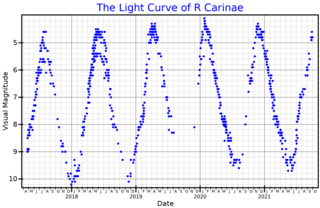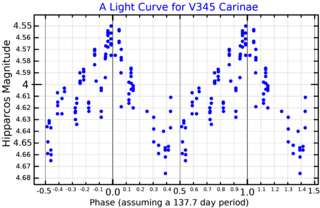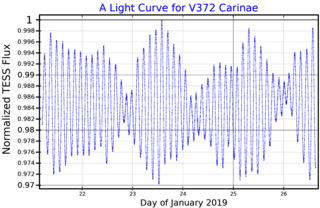
27 Canis Majoris is a binary star system in the northern constellation of Canis Major, located approximately 1,700 light years away from the Sun. It has the variable star designation EW Canis Majoris; 27 Canis Majoris is the Flamsteed designation. This system is visible to the naked eye as a dim, blue-white hued star with an apparent visual magnitude of +4.65. It is moving away from the Earth with a heliocentric radial velocity of 16 km/s.

11 Camelopardalis is a single star in the northern circumpolar constellation of Camelopardalis, located around 690 light years away from the Sun as determined by parallax. It has the variable star designation BV Camelopardalis; 11 Camelopardalis is the Flamsteed designation. This object is visible to the naked eye as a faint, blue-white hued star with a baseline apparent visual magnitude of +5.22. It forms a double star with 12 Camelopardalis, which is only 3 arcminutes away.
42 Camelopardalis is a single star in the constellation Camelopardalis, located roughly 770 light years away from the Sun. It is visible to the naked eye as a faint, blue-white hued star with an apparent visual magnitude of 5.14. The visual magnitude of the star is diminished by an extinction of 0.22 due to interstellar dust. It is moving further from the Earth with a heliocentric radial velocity of 3 km/s. 42 Camelopardalis has a peculiar velocity of 24.4+1.9
−2.1 km/s and may be a runaway star.
HD 94510 is a single star in the southern constellation of Carina, positioned near the northern constellation border with Vela. It has the Bayer designation u Carinae; HD 94520 is the identifier from the Henry Draper Catalogue. This object has an orange hue and is visible to the naked eye with an apparent visual magnitude that fluctuates around +3.78. The star is located at a distance of 95 light-years from the Sun based on parallax, and is drifting further away with a radial velocity of +8 km/s.
HD 90853 is a single star in the southern constellation Carina. It has the Bayer designation s Carinae, while HD 90853 is the identifier from the Henry Draper catalogue. This is a variable star with an apparent visual magnitude that ranges from 3.36 down to 3.51, and thus is bright enough to be visible to the naked eye. It is located at a distance of approximately 1,340 light-years from the Sun based on parallax, and has an absolute magnitude of −4.44. The star is drifting further away with a radial velocity of +9 km/s.

V343 Carinae is a blue-white star or star system in the southern constellation of Carina. It has the Bayer designation d Carinae, while V343 Carinae is a variable star designation. The star is visible to the naked eye with an apparent visual magnitude of 4.31. The distance to this object is approximately 1,440 light years based on parallax. It is drifting further away with a radial velocity of +13 km/s.
HD 80230 is a single star in the southern constellation of Carina, near the northern constellation border with Vela. It has the Bayer designation g Carinae, while HD 80230 is the star's identifier in the Henry Draper catalogue. This is a suspected variable star with a brightness that has been measured varying from magnitude 4.31 down to 4.35, both of which is bright enough for the star to be visible to the naked eye. The distance to this object is approximately 490 light years based on parallax, but it is drifting closer to the Sun with a radial velocity of −5 km/s.
HD 91942 is a single variable star in the constellation Carina. It has the Bayer designation r Carinae, while HD 91942 is the identifier from the Henry Draper catalogue. This orange-hued object is visible to the naked eye with an apparent visual magnitude of 4.45. Based on parallax measurements, it is located at a distance of approximately 1,180 light years from the Sun. The star has an absolute magnitude of −3.77, and is drifting further away with a radial velocity of +9.9 km/s.

R Carinae is a double star in the southern constellation of Carina. The brighter component is a variable star that can be viewed with the naked eye at peak brightness, but is usually too faint to be seen without a telescope, having an apparent visual magnitude that fluctuates around 7.43. This star is located at a distance of approximately 1,300 light years from the Sun based on parallax, and is drifting further away with a radial velocity of +28 km/s.

V344 Carinae is a single star in the southern constellation of Carina. It has the Bayer designation f Carinae, while V344 Carinae is its variable star designation. This star has a blue-white hue and is visible to the naked eye with an apparent visual magnitude that fluctuates around 4.50. Historically, it was mentioned in the Almagest, suggesting that some time around 130 BCE it was brighter than its current magnitude. This object is located at a distance of approximately 610 light-years from the Sun based on parallax. The star is drifting further away with a radial velocity of around +27 km/s.
HD 83944 is a star system in the constellation Carina. This has the Bayer designation m Carinae, while HD 83944 is the identifier from the Henry Draper catalogue. It is a suspected variable with an apparent visual magnitude that fluctuates around 4.51 with an amplitude of 0.5. The system is located at a distance of approximately 226 light years from the Sun based on parallax, and it has an absolute magnitude of 0.31. It is a member of the Carina association of co-moving stars.

V520 Carinae is a single star in the southern constellation of Carina. It has the Bayer designation w Carinae, while V520 Carinae is a variable star designation. The star has an orange hue and is faintly visible to the naked eye with an apparent visual magnitude that fluctuates around +4.58. It is located at a distance of approximately 1,140 light years from the Sun based on parallax, and it is drifting further away with a radial velocity of +9 km/s. It is a candidate member of the IC 2391 moving group of co-moving stars.

V345 Carinae is a star in the constellation Carina. It has the Bayer designation E Carinae; V345 Carinae is the variable star designation. The star has a blue-white hue and is faintly visible to the naked eye with an apparent visual magnitude that fluctuates around +4.66. Its actual brightness varies from magnitude +4.67 to +4.78 with a period of 137.7 days. Based on parallax measurements, it is located at a distance of approximately 1,010 light years from the Sun. It is drifting further away with a radial velocity of around +19 km/s.
T Carinae is a star in the southern constellation of Carina. Although given a variable star designation, it is now thought to be constant; the identifier HD 94776 from the Henry Draper catalogue may be used instead. It has an orange hue and is dimly visible to the naked eye with an apparent visual magnitude of 5.93. The distance to this object is approximately 285 light years based on parallax, and it has an absolute magnitude of 1.08. It is drifting closer to the Sun with a radial velocity of −26 km/s.

V448 Carinae is a single star in the constellation Carina. It has the Bayer designation O Carinae, while V448 Carinae is the variable star designation. This object has an orange hue and is dimly visible to the naked eye with an apparent visual magnitude that fluctuates around 5.60. It is located at a distance of approximately 680 light years from the Sun based on parallax, and is drifting further away with a radial velocity of around +26 km/s.

C1 Centauri is a single star in the southern constellation of Centaurus. It has the variable star designation V763 Centauri, while C1 Centauri is the Bayer designation. The star has a red hue and is dimly visibly to the naked eye with an apparent visual magnitude that fluctuates around +5.64. It is located at a distance of approximately 600 light years based on parallax, and has an absolute magnitude of −1.05. It is drifting further away with a radial velocity of +21 km/s. At one time it was a candidate member of the Zeta Herculis Moving Group but has since been excluded.

2 Vulpeculae is a binary star system in the northern constellation of Vulpecula, located around 1,800 light years away from the Sun. It is visible to the naked eye as a faint, blue-white hued star with an apparent visual magnitude of 5.43.

7 Ceti is a single, variable star in the equatorial constellation of Cetus. It has the variable star designation AE Ceti. The star is visible to the naked eye with a baseline apparent visual magnitude of 4.44. Based upon an annual parallax shift of only 7.3 mas, it is located roughly 450 light years away. It is moving closer to the Sun with a heliocentric radial velocity of −23 km/s. Eggen (1965) listed it as a probable member of the Wolf 630 group of co-moving stars.

V372 Carinae is a single star in the southern constellation of Carina. Located around 1300 light-years distant. It shines with a luminosity approximately 1742 times that of the Sun and has a surface temperature of 14132 K. It is a Beta Cephei variable. A magnitude 5.7 star, it will be faintly visible on moonless nights to the naked eye of a person located far from city lights.

12 Lacertae is a wide binary star system in the northern constellation of Lacerta, located roughly 1,260 light years away from the Sun based on parallax. It is visible to the naked eye as a dim, blue-white hued point of light with a baseline apparent visual magnitude of 5.23. The system is drifting closer to the Earth with a mean heliocentric radial velocity of –12.5. It is a probable member of the I Lacertae OB association.













